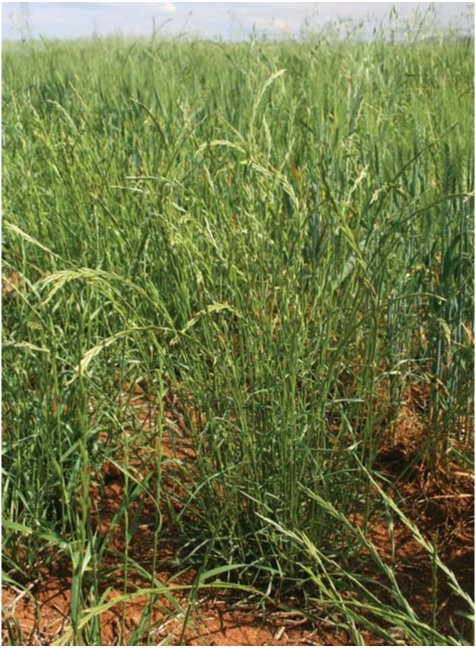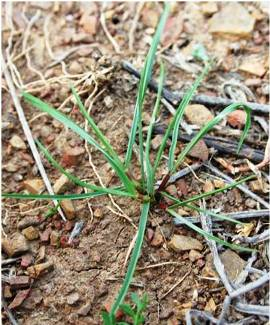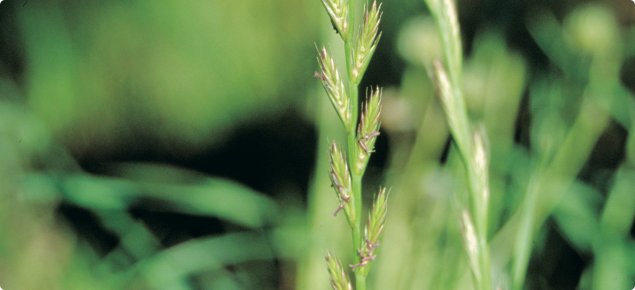Identification and attributes
Latin name - Lolium rigidum
Alternative names — Wimmera ryegrass, ryegrass
Distinguishing features

Annual ryegrass is hairless and has bright green, narrow leaves. The leaves are shiny, especially on the back of the blade. It has a wide ligule, long auricles and the emerging leaf is folded. The base (below ground) is often reddish purple in colour and seedlings exude a clear sap when crushed.
Mature plants are erect and up to 900 millimetres (mm) in height. The inflorescence (flowering stems) are flat and up to 300mm in length. Spikelets have 3-9 flowers and the husk is almost the same length as the spikelet.
Seeds are relatively flat, 4-6mm long, 1mm wide and straw-coloured, with the seed embryo often visible through the outer layers. They are held securely to the flower stem and significant force is needed to detach them either as individual seeds or as part of the flower stem.
Biology
Annual ryegrass is a winter to spring growing weed that can emerge from late autumn through to early spring. Ideal conditions for germination of annual ryegrass include a significant autumn/winter rain event and seeds located 20mm deep in the soil. Germination reduces with increasing seed depth, stopping at about 100mm.
Most shallow seed will germinate during autumn and early winter. The peak germination (80% of seeds) occurs at the break-of-season after the first two falls of rain that exceed 20mm. Newly-formed seeds of annual ryegrass are dormant for the first 8-9 weeks. Less than 1% carryover of viable residual seed remains after late winter in undisturbed soil, indicating that the seed is relatively short-lived.
Why is it a major weed?
As one of the most serious and costly weeds in southern Australia's winter cropping systems, annual ryegrass produces an extremely high number of seeds per plant. Dense stands (>100 plants/m2) can produce up to 45 000 seed per square metre under ideal conditions. Annual ryegrass is highly competitive and can compete with crops as early as the two-leaf crop stage. Annual ryegrass also is a host for the bacteria Clavibacter spp., which cause annual ryegrass toxicity (ARGT) and can be infected by ergot fungus.
Herbicide resistance
Many populations of annual ryegrass have developed resistance to both selective and non-selective herbicides. Repeated use of herbicides from the same mode-of-action group (particularly the high-risk Group 1) have lead to herbicide-resistant individuals. Annual ryegrass has developed resistance to the following mode-of-action herbicide groups in Western Australia.
- Group 1 — ‘fops’ (for example, diclofop-methyl) and 'dims' (for example, sethoxydim)
- Group 2 — sulfonureas (for example, chlorsulfuron and sulfometuron) and imidazolinones (for example imazapic)
- Group 3 — trifluralin
- Group 5 — triazines (atrazine and simazine) and substituted ureas (for example, diuron)
- Group 9 — glyphosate
- Group 34 — triazoles (for exampe, amitrole)

.
There are now more than 23 confirmed cases of glyphosate-resistant ryegrass populations in Australia mostly from cropping paddocks. There are at least three populations recorded in WA. There has also been a recent case of resistance to paraquat in annual ryegrass been found in South Australia.
Tactics for integrated weed management
There are many tactics that should be considered when developing an integrated plan to manage annual ryegrass (Lolium rigidum). These include: improving crop competition; burning residues; inversion ploughing; autumn tickle; using herbicides and more.
| Tactic | Most likely % control (range) | Comments on use |
|---|---|---|
| Improving crop competition | 50 (20-80) | Optimum sowing rates essential. Row spacing >250mm will reduce crop competitiveness. Sow on time |
| Burning residues | 50 (0-90) | Avoid grazing crop residues. Use a hot fire back-burning into the wind |
| Inversion ploughing | 95 (80-99) | Bury seed 100mm deep. Use of skimmers on plough is essential for good results |
| Autumn tickle | 15 (0-50) | Only effective on previous year's seed-set |
| Fallow and pre-sowing cultivation | 60 (0-90) | Cultivation may lead to increased ryegrass in the crop. Use in combination with a knockdown herbicide. Use cultivators that bury seed. Cultivate during dry weather to reduce transplanting |
| Knockdown (non-selective) herbicides for fallow and pre-sowing control | 80 (30-95) | Avoid overuse of the one herbicide group. Add carfentrazone if annual ryegrass has less than two leaves |
| Double knockdown or ‘doubleknock’ | 95 (80-99) | Reduces the likelihood of glyphosate resistance. Use glyphosate followed by SpraySeed® 3-14 days later |
| Pre-emergent herbicides | 70 (50-90) | Note incorporation requirements for different products and planting systems. Rotate between herbicide groups |
| Selective post-emergent herbicides | 90 (80-95) | Apply as early as possible after the annual ryegrass has two leaves to reduce yield losses in cereals |
| Spray-topping with selective herbicides | 80 (60-90) | Apply before milk dough stage of annual ryegrass |
| Crop-topping with non-selective herbicides | 70 (50-90) | Note stage of crop compared to stage of annual ryegrass. Often not possible to achieve without crop loss |
| Pasture spray-topping | 80 (30-99) | Graze heavily in spring to synchronise flowering |
| Silage and hay – crops and pastures | 80 (50-95) | Most commonly used where there is a mass of resistant annual ryegrass growth. Follow up with herbicides or grazing to control regrowth |
| Renovation crops and pastures – green manuring, brown manuring, mulching and hay freezing | 90 (70-95) | Most commonly used where there is a mass of resistant annual ryegrass growth. Follow up with herbicides or grazing to control regrowth |
| Grazing – actively managing weeds in pastures | 50 (20-80) | Graze heavily in autumn to reduce annual ryegrass plant numbers. Graze heavily in spring to reduce seed-set |
| Weed seed collection at harvest | 65 (40-80) | Best results where crop is harvested as soon as possible before weeds lodge or shatter |
| Sow weed-free seed | 85 (50-99) | Reduces the risk of introducing resistant annual ryegrass to the paddock with crop seed |

